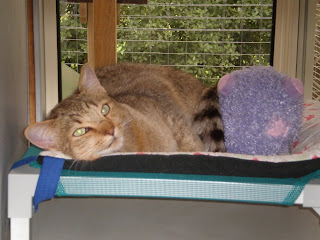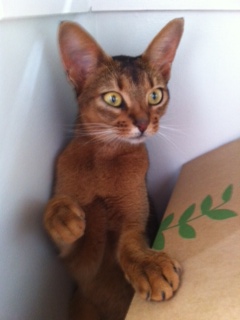 The Australian Mist was developed over more than twenty
years and have a large gene pool, derived from over 30 foundation cats,
half burmese, and a quarter each Abyssinian and Domestic. Burmese
contributed the "laid back" nature, four of the colours
and some of the pattern, as well as general size and confirmation. From
the Abyssinian came the beautiful ticking to develop the pattern, two
colours, and a touch of lively intelligence. Domestics contributed to
the best spots, but primarily to vigour, with a dose of "uncosseted" cat
genes improving teeth, kidneys, mothering qualities, and helping to
stabalise litter sizes around the feline average of four kittens.The
exciting marbled pattern, accepted as part of the breed in 1997 has
"popped up" throughout the development of the breed and is growing in
popularity.
The Australian Mist was developed over more than twenty
years and have a large gene pool, derived from over 30 foundation cats,
half burmese, and a quarter each Abyssinian and Domestic. Burmese
contributed the "laid back" nature, four of the colours
and some of the pattern, as well as general size and confirmation. From
the Abyssinian came the beautiful ticking to develop the pattern, two
colours, and a touch of lively intelligence. Domestics contributed to
the best spots, but primarily to vigour, with a dose of "uncosseted" cat
genes improving teeth, kidneys, mothering qualities, and helping to
stabalise litter sizes around the feline average of four kittens.The
exciting marbled pattern, accepted as part of the breed in 1997 has
"popped up" throughout the development of the breed and is growing in
popularity.
These delectable short-haired cats were the brain-child of Dr. Truda
Straede (Nintu Cattery) and were developed from the idea to full
register over nine years from 1977. This wholly AUSTRALIAN breed of cat
is now recognized by governing councils Australia wide.
There
is nothing extreme about Australian Mist, they are of moderate size,
medium boned, rounded of head, with large eyes and ears. The coat is
short, but resilient, the tail is plumply furred. The colours are warm
brown, blue, chocolate, lilac, gold and peach; the pattern is of
delicate spots or intricate marbled swirls against a misty ground, with
legs and tail ringed and barred, and the face lined. Eyes are large and
expressive in a range of greens. The nose, chin and whiskerpads are
broad giving the face a generous expression.
 |
| Carmen Miranda |
They make perfect pets for children of all ages, even very young ones,
as they are tolerant of handling, and are not inclined to scratch. As
kittens they are lively, but sober up a little on maturity. Their life
expectancy is in the mid to late teens. Australian Mists thrive on
human contact, making them happy to remain indoors between dusk and dawn
or to be wholly indoor pets, an advantage as most people now prefer to
keep their pets indoors. This also protects native wildlife. Some Mists
can be trained to go for walks on a lead. Their tendency to crawl into
the nearest lap with or without invitation and to constantly hang around
to see what people are up to, makes them excellent companions for home
workers. De-sexed cats and kittens fit in easily with all
sorts of cats and dogs. These qualities create a truly companionable
pet for any household and lifestyle, an Australian Mist will quickly
become a member of the family.
* This information was gathered from www.purina.com.au










































